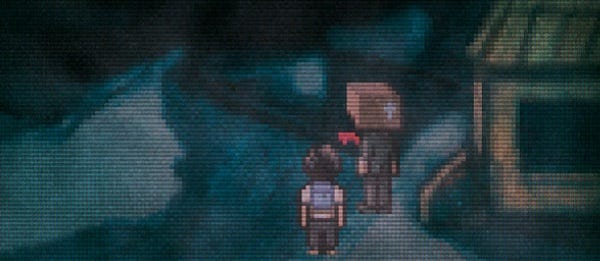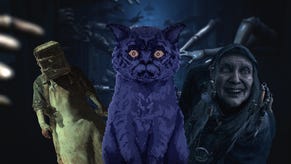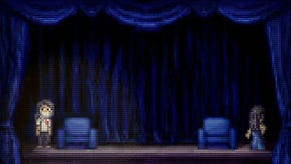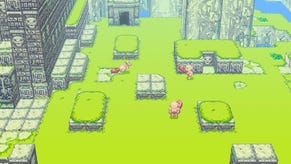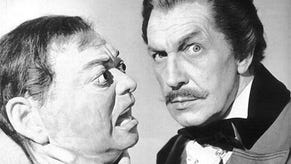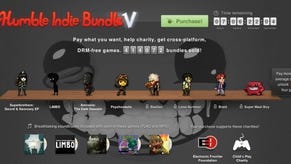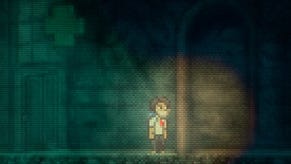Peel Back The Dark: Lone Survivor Interview Part 2
Shadow Puppetry
Following on from our discussion of the game's development and inspirations, this concluding part of our interview with Jasper Byrne, Lone Survivor's creator, explores some of the themes and moods invoked by the horror adventure. The fourth wall is sundered, dreams are dissected and just what the heck are those pills all about? Spoilers, obviously.
RPS: I think I’m still lost on a huge amount of things. When I first finished the game I felt like I didn’t have any closure but then half an hour later I thought, ‘OK, I do’ and wanted to go back and play again.
Byrne: Which ending did you get first?
RPS: I got the blue ending.
Byrne: A lot of people get that and have that reaction. If you get the other ending first it’s quite a different reaction but I’d prefer people to get blue first because there’s more of an incentive to go back.
RPS: I think people are more likely to get blue first. Which says something about how we play games…
Byrne: Yeah, first time. You want to see it, to get to the next bit.
RPS: I think there’s also a certain desperation. You want to keep pushing on. It’s strange actually; in terms of incentive for the player, it’s to stay alive. But very quickly it starts to feel like an escape. And I don’t think there’s any point where he actually thinks I’ve got to get the Hell out of here, because he’s got safety and sanctuary.
Byrne: Yeah, he’s not really trying very hard to get out of the building. If he wanted to he could break the door down onto the fire escape. He’s sort of comfortable in it.
That’s part of my life as well. I can be quite…the Japanese word is Hikikomori, I go into my cave and don’t come out. There’s a big phenomenon in Japan of people who don’t leave their rooms whatsoever for years on end. I’m not actually Hikikomori in that sense, I’m just quite agoraphobic, quite shy.
There’s something about that in the game, the sanctuary of the bedroom. Possibly even his diaries, something creative that he’s working on in an attempt to escape.
RPS: It’s one of the things that reminded me most of Silent Hill. There are so many analogues to draw but some are unfair because when you do reference Silent Hill you’re often doing it in an interesting way. Rather than being a 2D, retro version, it’s actually alluding in an interesting way, just like with Lynch. But one thing that did remind me of Silent Hill is how laidback he is as a character.
Byrne: (laughs) I love that. There’s something brilliant about all of those characters. Particularly…
RPS: Sunderland?
Byrne: Yeah, James Sunderland. He’s just very…and actually the first guy as well, Harry Mason, I think maybe there it’s more to do with the stilted acting.
RPS: That’s my feeling.
Byrne: But in the second one it feels very deliberate. A lot of people criticise the acting in that game but I think it’s spot on. I wouldn’t change it.
RPS: They did change it!
Byrne: I can’t even look at the HD ones.
RPS: I’ve been playing them actually. And with Silent Hill 2 you can choose the original voices. I haven’t even listened to the new ones. I can’t imagine what it would look like.
Byrne: Even changing the resolution seems wrong. Every texture and polygon was designed for that resolution. When you up it there’s suddenly this extra space and it’s smoother than it should be. Some of them come out OK. The Ico collection is really good. I wouldn’t take the PS2 version over that.
RPS: Just to go back to the protagonist, who’s not passive, but…
Byrne: Almost blasé. He’s very calm. I think what it gives a sense of is that he’s been expericing this for a long time. He’s used to it. Maybe the beginning of Silent Hill 2 isn’t the first monster James has seen, not the first hallucination he’s had, waking, dreaming or whatever.
My game just starts. There’s no trigger event, he’s just there and he’s been there for an undetermined amount of time. I guess I wanted to say that it’s not just starting, maybe he’s used to this. It’s been his routine for a long time.
Somebody actually suggested in the intro bit, which was added towards the end of development, that he should freak out when he sees the monster, have an animation where his eyes pop or something. But instead he just says ‘damn’, it’s like ‘oh dear, it’s another one’.
RPS: ‘It’s happening again’.
Byrne: Yeah. ‘Not this again’. I mean, the monsters aren’t…monsters are they?
RPS: No.
Byrne: What we’re seeing on screen maybe isn’t what he’s seeing.
RPS: Exactly. What he’s seeing may not be what’s there but we may not even see what he thinks is there. So there are three levels of reality.
Byrne: Yeah, and that’s the fun you can have with dream logic. I’ve been wanting to explore that for a long time. The Silent Hill universe, or whatever the word is, is kind of based on an otherworld that switches in and out, whereas in my game he’s in a constant state of flux.
Obviously there’s a lot of more superficial aspects that take a template from Silent Hill but I do feel that the story itself is a different one but people haven’t got to it yet. It’s hard to talk about without giving everything away.
RPS: Do you think part of the reason people haven’t found the 'real' story yet is because they keep bashing their head against the allusions and what they expect?
Byrne: I think so. I kind of regret…I mean, Terry [Cavanagh] is a very good friend and he said right before the end, ‘you are going to take that item pickup sound out, right?’ And I said, ‘no, man, that’s great!’ It’s not the Silent Hill one but it’s similar. Obviously it’s there as a superficial nod to it.
RPS: The game breaks the fourth wall a lot.
Byrne: It’s deliberately fucking with you. I’m known for that game [Soundless Mountain] which is a demake of Silent Hill 2. A lot of people asked me to finish that or expand it and a lot of Lone Survivor is giving nods to fans of that game. Here is the extended version but with a whole new story and now something of its own.
Obviously I’m not going to try and deny my influences, I’m wearing them on my sleeve, but I think especially with Silent Hill, the mechanics and the story are quite different, but on a superficial level it does appear quite a lot like it. But that’s a way of luring people in, getting them into a comfortable place to play it.
RPS: This could almost be going too far…I was going to say deep but that sounds clever. Let’s say sideways. There was a point I was playing and I thought if this is the dream logic or psychological nightmare that’s somebody has created in this situation, is it just a guy who’s played a lot of Silent Hill?
Byrne: Absolutely, that’s definitely a level that I considered. With the game arcade and the references to that, I was trying to suggest that he was a game player, and he did probably know about these games.
RPS: I think the game arcade was probably my favourite bit. It’s got humour to it but it’s incredibly clever because it highlights how people respond to this sort of game or film so often. It’s how I responded to the first trailer!
Byrne: I very nearly removed those descriptions right at the end as well. I very nearly disabled all the hotspots and just left it as a little gag. I’m glad I left it in now. It does make the point I wanted to make, which is that this is not a game about zombies.
Some people still play the whole thing and think it’s a game about zombies, which is fine, it’s brilliant, but I’m glad people have looked more deeply into it.
(It transpires that Jasper is playing Silent Hill: Shattered Memories for the first time)
RPS: I assumed the psychology element in your game was a nod to that!
Byrne:I only found about that recently. I knew the rough premise of the game but I didn’t know it had a psych report and that sort of stuff.
RPS: It can be very obvious where the triggers are in Shattered Memories after a while.
Byrne: The scene when he goes back to his family home and it isn’t his home is great though, absolutely terrifying. It’s kind of what I was going for with the party scene.
RPS: I was going to say exactly that. It’s the first moment in Lone Survivor that really got under my skin. It’s just so strange.
Byrne: I’ve had it in dreams where I’m trying to tell something to somebody, trying to warn them, but nobody’s listening. There’s something really weird about that. I don’t know if it’s just me.
RPS: I think it’s almost the intellectual equivalent of the running away from something dream. It’s the same sort of feeling. The animation in that scene is brilliant as well. It’s easy to pass over the visuals but there’s so much going on. Even the little fidgets the main character does all the time, he constantly looks uncomfortable in his own skin. The people at the party are a counterpoint to that and it’s communicated through these small animations.
Byrne: Yeah, the discomfort is hugely important.
RPS: And then, speaking of animation, the fingerclick. With the music as well.
Byrne: (clicks) That’s a lot of programming actually!
RPS: It’s probably the most lynchian moment in the entire game. Sinister, cool and humorous all at once.
Byrne: It’s another thing that he [Lynch] does that I just love. You can’t have horror without something to balance it out. Lynch has these sentimental scenes or really suddenly comic scenes, that incongruousness…
RPS: Everything is hyper-real.
Byrne: Yeah. And my guy does feel a lot and talks a lot. He’s one of those heroes, a sort of sensitive soul. He’s very emotional. A little bit like the Blue Velvet character played by Kyle MacLachlan. Slightly romantic even, with his cat. (laughs)
RPS: There’s the sense as well through the sleep sequences, when he meets these other characters, that they are other powers or beings pulling the strings behind all this. Whether they’re doctors, friends, family, or otherworldly sinister things. That sense of control, with The Director as well, where did that come from?
Byrne: One theme that nobody has really picked up on, and I’m happy to share this, is the idea of nature and nurture in the game. I can probably give away this one. The two colours in the game represent one or the other, so that’s a big hint.
Among other things, green is used as a colour to represent nurture and blue is a colour representing nature. So that should give you a good hint of what the dreams are representing. There are other ties between characters that aren’t called out but are implicit. I don’t know to what extent I should talk about that.
RPS: I certainly get the feeling, and it’s a feeling rather than a thought, that everybody else knows each other, they’re all connected. Not quite like the Lodge in Twin Peaks, but a place that they sit and talk, and then every now and then they have to go and do their thing.
Byrne: You hit on something with the idea of an external or supernatural force, which they could appear like, these dream figures, but actually they might also have a different relationship outside of the dream.
There are different places that they exist in different forms, not necessarily at the same time as one another, but there’s an intersection. The game as the player sees it is one of those times and one of those places, occasionally shifting. Surprisingly, like you say it’s not a terrifying game, but it can be unsettling because you’re never sure what you’re seeing.
RPS: You’re unsure of what you’re seeing and you’re certainly unsure of what it means. That’s very disturbing. The narrator seems to become less reliable as well.
Byrne: Yeah, and alongside that I have to keep the story of the zombie outbreak, the parallel story. One of the harder parts, storywise, was in the later game, once you’re out of the apartment, was pulling the rug out from under the player’s feet again.
You’ve almost forgotten some of the stuff that went on earlier and you’re in escape mode. You come out and it could easily turn into a classic zombie, escape the city, Dawn of the Dead type adventure at that point. But I worked hard to make certain points in the story that switch that all around again.
RPS: Hank in the gunshop is great. You do a lot with a little there. He represents a great deal of what’s happened elsewhere. He does a lot of legwork for you that guy.
Byrne: I made him very quickly. I got a lot out of a short bit of code. I made Hank in a couple of days and just the idea of trading, which was there from the start with the blue pills, well that adds the other end of it. I don’t know if you did this but you can give him health tonics as well.
RPS: (laughs) Only on my second playthrough. I felt like such a bastard that I hadn’t even thought of it.
Byrne: There are a few hints there. You have the option of asking if there’s a cure or anything…
RPS: I ignored the hints.
Byrne: That was another day’s scripting, adding that second option, and it balanced that whole area out perfectly. He had a little game with him; he starts in the middle and you can either send him up or down. It’s your character in miniature.
RPS: I did a terrible thing. I went to the final boss, as it were, and died. Didn’t have enough bullets. So I went to Hank, gave him pills, took bullets. Basically feeding him pills.
Byrne: Three pills to him gives you enough to kill the boss, it’s designed that way.
Some people don’t ever talk to him either. Once they’ve traded initially they never actually talk to him. If you do, you notice that his condition is getting worse. To some people he’s just a vending machine. If you talk, he starts saying ‘itchy, itchy, itchy’.
RPS: For me the main character said something like ‘this is my fault’. Oops.
Byrne: People occasionally post images of lines that I don’t remember writing. There are so many hundreds of lines that are completely random. You’ll eat a fruitdrop and there’s like a hundred fruitdrop lines. Fifty descriptions for your first coffee of the day, fifty for your second. And that’s for both types of coffee. There are lines I’ll never see myself. Sometimes I think, ‘did I really put that in there’?
People find everything though. They find every bug. Or they hack solutions to things, changing XML files. Public beta testing is really good. If it was the kind of game where I could do a public alpha or something, I could see how interesting that could be for changing the game. It’s amazing what the community do.
After a couple of days, a Wiki’s shown up and people have taken screenshots of every item in the game.
RPS: People emailed me after the review asking for pointers and I always try to say, ‘take a break and come back’. Once you’re playing just to progress, it’s time to step back and come back when you can enjoy the atmosphere a little more.
Byrne: I like it when people find out about things that they missed when playing and that makes them want to go back and play again. Maybe they saw the cat once and didn’t get close to it so they want to go back and do that again.
One thing with Silent Hill games is that despite the very different endings, you don’t want to play the game again particularly.
RPS: That’s probably to do with length as well. Lone Survivor isn’t a short game but you could get through it quickly if you wanted…
Byrne: You can get through it in two hours if you really want to. It’s a wide game rather than a long one. I call it an Icebergvania. The tip is visible but there’s a shitload underneath.
RPS: I look forward to finding more. Thanks for your time.
Lone Survivor is available now, direct from its very own website or through Steam where a 20% discount is valid until April 30th. Here's wot I thought.
